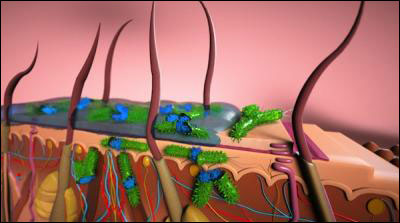Ionic liquids show promise against biofilm-protected bacteria
ionic liquids may be an effective resource in combating bacterial skin infections protected by biofilm, according to recent study data published in the Proceedings of the National Academy of Science.
Researchers examined the use of ionic liquids to combat antibiotic-resistant bacterial biofilms in skin and for topical transdermal drug delivery. The collaborative study identified ionic liquids that are effective at disrupting biofilms, neutralizing pathogens and enhancing delivery of antibiotics.
“In essence, we may have stumbled onto a magic bullet,” David Fox, PhD, of Los Alamos National Laboratory, New Mexico, said in a press release. “Through a robust screening strategy, our research team has identified a unique class of materials … which both neutralize biofilm-forming pathogens and deliver drugs through the skin.”

Figure 1. An artist's rendition of a cross section of skin layers (stratum corneum, epidermis and dermis) shows topical application of an ionic liquid for combating a skin-borne bacterial infection. The ionic liquid can be formulated with antibiotics for transdermal drug delivery or it can directly kill the bacteria infesting the skin surface.
Source: Peter Allen, University of California, Santa Barbara
The researchers found that ionic liquids had strong antimicrobial activity, minimal toxicity to epithelial cells and to skin, and effective permeation enhancement for drug delivery. Specifically, the ionic liquid choline-geranate was comparable with bleach treatment against established biofilms of the pathogen Salmonella enterica and more effective than bleach with Pseudomonas aeruginosa. In addition, choline-geranate increased delivery of the antibiotic cefadroxil by more than 16-fold into the deep tissue layers of the skin without inducing irritation.
“In several cases, we found the ionic liquid was more efficacious on a biofilm than a standard bleach treatment and exhibited minimal cytotoxicity effects on human cell lines,” Fox said. “This has excellent prospects for aiding antibiotic delivery to the pathogen through biofilm disruption but, most interestingly, the ionic liquids themselves are quite effective for pathogen neutralization.”
Ionic liquids can be derived from cheap, FDA-approved materials and are extremely stable in high temperatures and pressures. As such, their application could especially be useful for military medical treatments where soldiers in the field can be exposed to difficult-to-treat bacterial infections, Fox said.
Biofilms are often difficult to treat because they are found beneath an intact layer of skin. Biofilm-protected bacteria are 50 to 1,000 times more resistant to antibiotics than planktonic bacteria and make up approximately 80% of bacterial infections in humans, the researchers wrote.
Zakrewsky M. Proc Natl Acad Sci. 2014;doi:10.1073/pnas.1403995111.
